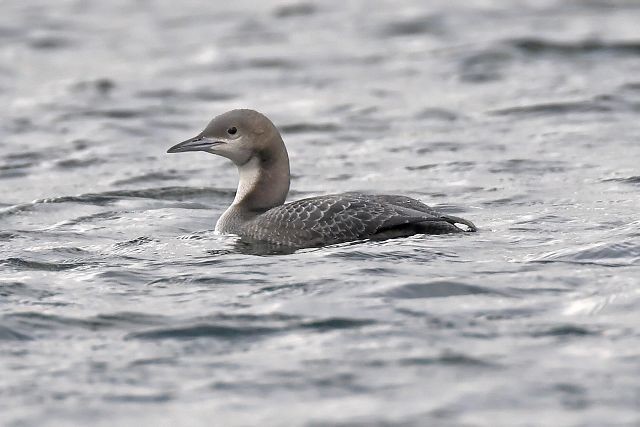
Pacific Diver, Farnham GPs, North Yorkshire (Tom Tams).
The bird's discovery
June Atkinson discovered Europe's apparently first confirmed Pacific Diver at 14:45 on the afternoon of January 12th on the South Lake at Farnham Gravel Pits on the outskirts of Knaresborough. Although initially confident in the identification as a Black-throated Diver, the observer was concerned by the fact that the bird lacked a prominent white thigh patch. June contacted J R Mather, who was well aware of the possibility that this bird could in fact be a Pacific Diver.
Luckily the bird was still present the next day though it had now moved to the North Lake. Although the views were more distant here, the bird was still close enough to check, and double-check, the finer points of identification. The bird indeed appeared to be a Pacific Diver, a potential first for both Britain and the Western Palearctic.
Well aware of the enormity of the record, the observers were faced with a dilemma. Farnham GPs are privately owned and members of the Harrogate and District Naturalists' Society birdwatch there as guests of the landowner and the fishing club who rent out the lakes. Access to the site is for key-holders only, and adding to the complications the anglers also share the site with both a boating club and a gun club. Seemingly trapped between the devil and the deep blue sea, the finders reluctantly decided initially to suppress the news of this significant discovery.
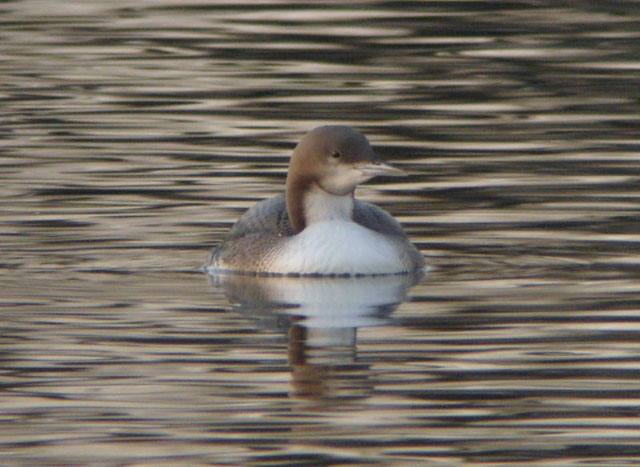
Pacific Diver, Farnham GPs, North Yorkshire. Although not much of a colour show, this new bird for the Western Palearctic was considered by many to be, albeit subtly, very beautiful (Paul Hackett).
The site still awaits its first record of Black-throated Diver! It was surprising to us in this day how long the news was kept quiet. Inevitably, though, the news leaked out. John McLoughlin (JM) and Martin Garner (MG) heard the rumour of the bird's presence via keen Yorkshire lister Garry Taylor and all three arrived at Farnham Gravel Pits on Monday morning 29th January. Fortunately the site had formerly been a local patch for JM. Thus, via this old friendship, we were met and let in by the bird's finder. Any scepticism or uncertainty over what we would find was quickly displaced with amazement, as the bird present was, in every way, a perfect specimen of a juvenile Pacific Diver. The leaked news could now be corroborated at a level of confidence that quickly mobilized the UK birding community. Faced with a large twitch to manage, both the anglers and local birders pulled together and opened the gates to visitors from across the country. The initial fear of such an event was swept away by exuberance as they shared in the enjoyment of both the bird and the event - no doubt aided by the sight of the smiling faces of many of the nation's most famous listers. Donations collected on site are to be put to funding essential management and maintenance work.
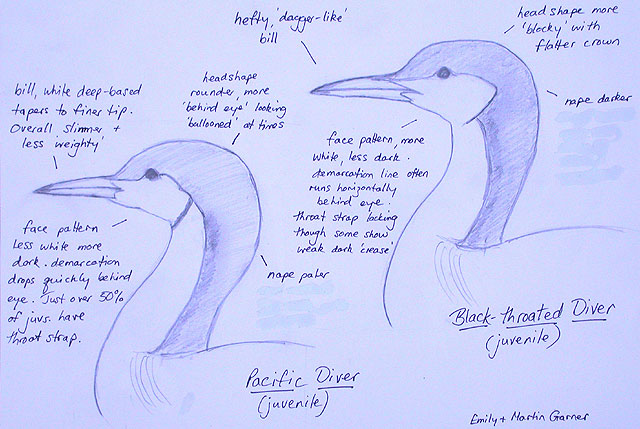
Pacific and Black-throated Diver. This comparative illustration shows the more identifiable and seemingly more typical examples of the two species. While there are perhaps no outstandingly diagnostic features, a number of subtle differences collectively produce a quite different overall appearance (Emily and Martin Garner).
Identification of Pacific Diver
Given a breeding range that reaches to Baffin Island in the Canadian Arctic and possibly even Western Greenland (Russell 2002), the vagrancy likelihood of Pacific Diver is actually very high. However, whilst Pacific Diver is considered to be the most numerous diver species in North America, in winter it is also clearly the most pelagic. It is possible off British Columbia to see congregations numbering over 1,000 at the entrance to the Straights of Georgia (MG pers. observations) but the species becomes much scarcer along the coastline. One could easily imagine odd birds regularly reaching the continental shelf off the western approaches of Britain and Ireland, but such occurrences wouldn't provide sufficiently adequate views for a firm identification. As to the bird's likely origins, we probably need look no further than the widespread and exceptional arrival to inland sites of Great Northern Divers, almost certainly from a northwestern vector, forced inland by a continuous westerly airstreams over the Christmas period. It would seem that the conditions which brought the Great Northern Divers also provided the ideal circumstances for this amazing record.
The key criteria for identifying Pacific Diver have only recently been elucidated. As recently as 1990, in comparing Black-throated and Pacific Diver, Ken Kaufman, stated that "...the field identification of these two species in winter should be considered an unresolved challenge that all of us have to look forward to." A Black-throated Diver on the California coast in 1993 spawned a very helpful paper on identifying juveniles of the two species (Reinking and Howell 1993; click here for the online version). Then in 1995, the identification of Pacific Diver was treated in depth by Andrew Birch and Cin-Ty Lee in Birding World 8:458-466 (and again in Birding 19: 106-115). The criteria discussed therein still hold true today. The identification of a vagrant Pacific Diver in juvenile plumage could appear particularly challenging. Of the two most frequently quoted features, the dark 'throat strap' is only present on just over half of individuals, while Black-throated Diver can show a weak or broken strap. Only the plumage of the rear flanks is considered to be diagnostic (being white in Black-throated Diver and dark in Pacific Diver). However there are a number of subtle characters which, while not individually diagnostic, can produce a distinctive appearance. When present collectively, as in the case of the Yorkshire bird, a combination of these characters render identification relatively straightforward.
Size
There is a considerable size difference between Black-throated Diver and Pacific Diver (the latter being approximately 10% smaller), which can be effectively illustrated by comparing field experiences between different continents. In a Western Palearctic context, the normal challenge in winter is the separation of Black-throated from Great Northern Diver (due in part to their similar size and bulk and, to some extent, head shape and 'weight' of bill), while the identification of Red-throated Divers is usually less problematic. However, in eastern North America, Pacific Divers are frequently confused with Red-throated Divers that show particularly contrasting plumage tones (and juveniles with darker 'faces') and occasionally very small young Great Northern Divers (James Smith, pers. comm.). While there were no other divers for direct size comparison on Farnham Gravel Pits, it was actually quite easy to be momentarily fooled by a Great Crested Grebe when trying to relocate the bird as it resurfaced from a dive. This introduced an interesting perspective on the bird's true size! Although highly subjective, the Yorkshire bird certainly conjured up the impression of a rather compact, lightweight bird more reminiscent of a Red-throated than Black-throated Diver in size. A juvenile Black-throated Diver seen later the same week by MG was immediately impressive as larger and 'chunkier'-looking bird.
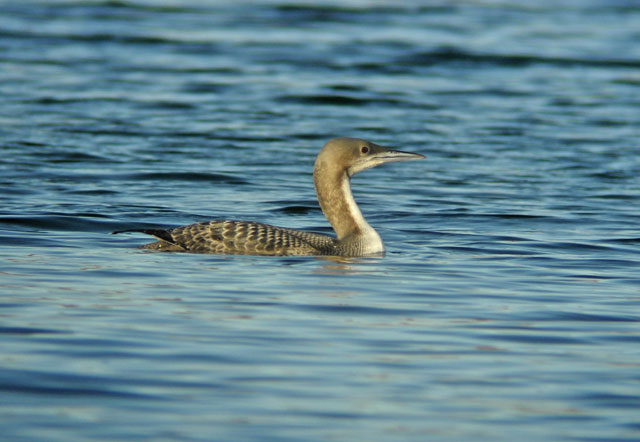
Pacific Diver, Farnham GPs, North Yorkshire. Comparing this photograph with the image immediately below helpfully demonstrates that caution should be exercised when assessing Diver head shapes. Here the sleek appearance, perhaps during a bout of diving, causes the bill to appear somewhat larger. Nevertheless the face pattern, and complete dark throat bridle, should immediately attract attention, even if assessment of flank pattern were not possible, due to the bird being more submerged in the water (Paul Hackett).
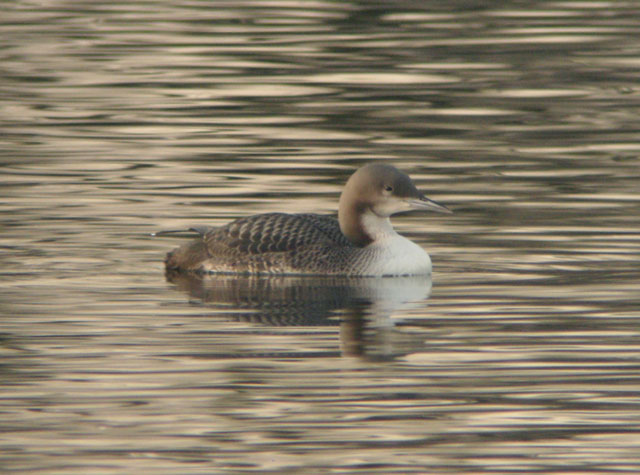
Pacific Diver, Farnham GPs, North Yorkshire. In this more relaxed pose it all becomes clear! The combination of a 'puffy' rounded head shape, rather fine-looking bill, extensive dark facial pattern with dark throat bridle and mostly dark flanks, clinches a Pacific Diver! The slight line of white along the water line is normal and although not in a more helpful profile pose, the rear flank area, which would be obviously white on a Black-throated Diver, is obviously dark here (Paul Hackett).
Rear flank patch
On relaxed individuals, Black-throated Diver always shows at least an obvious up-flared white patch on the rear flanks which, depending on posture, continues into a white line running the full length of the flanks and clearly visible just above a calm water line. Occasionally, when low slung in the water, the white rear flank patch can temporarily 'disappear'. The same rear flank area is entirely dark on Pacific Diver, and is similarly mostly dark, or all-dark, along the length of the flanks (with only a narrow white line visible at best). White only appears here on Pacific Divers when they are 'riding high' in the water, or when rolling to preen. On the Yorkshire bird it was easy to see that the rear flank area was impressively dark, and often no white was visible at all along the whole length of the flanks when the bird was relaxed on the water.
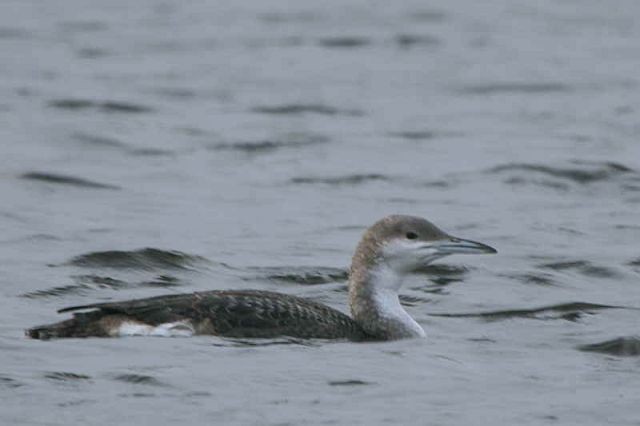
Black-throated Diver, Glanderston Dam, Clyde. The hefty bill, face pattern and rear up-flared patch of white on the rear flank immediately identifies this individual bird as a Black-throated Diver with the pale-fringed scapulars of juvenile plumage. The face pattern has more white than typical Pacific Diver and the demarcation between dark and light runs for some way in a horizontal line beyond the eye. The head shape consists of slight forehead bump and flat crown typical of Black-throated Diver (Ian Fulton).
Vent strap
A dark bar running through the vent was originally described as present in all plumages of Pacific Diver, but faint or absent in Black-throated Diver (Walsh 1988) and this was further researched by Reinking and Howell (1993), who found that 93.5 % of juvenile Pacific Divers examined had a complete brown vent strap. Only 69.5 % of adults in both summer and winter plumages showed a complete vent strap, while five out of six Black-throated Divers examined had only a partial vent strap at best. Birch and Lee (1995) found no Black-throated Divers with a complete vent strap, and of those with a partial vent strap it was less extensive than on even the most poorly marked Pacific Diver. Thus a complete dark vent strap is possibly diagnostic, or at least highly indicative, of Pacific Diver and is most frequently present on juveniles. Although the feature is very difficult to confirm in normal field conditions, the circumstances of the observation and quality of modern photography meant it was quickly possible to confirm the presence of an apparently complete dark vent strap on the Yorkshire bird.
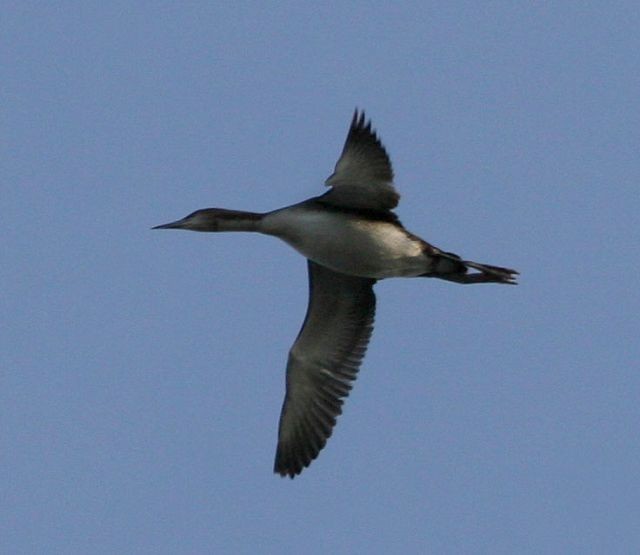
Pacific Diver, Farnham GPs, North Yorkshire. Those fortunate enough to see this individual in flight, while perhaps contemplating its departure; also had the opportunity to see (and photograph) most clearly the complete dark vent strap which may be a diagnostic feature of Pacific Diver. It is present on over 90% of juveniles (Mark Breaks).
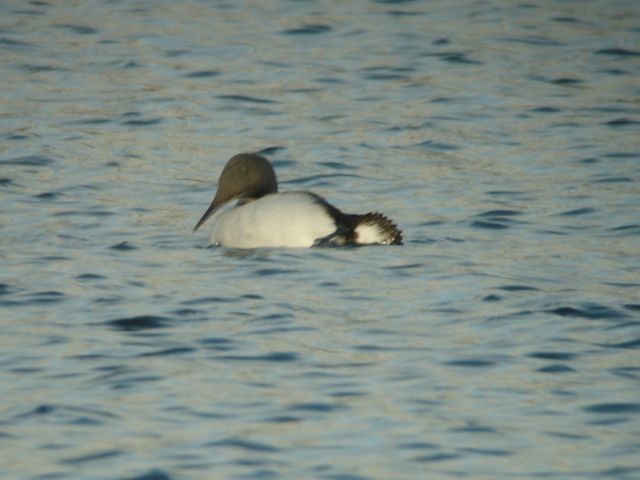
Pacific Diver, Farnham GPs, North Yorkshire. Even on the water it was soon possible to ascertain the presence of the dark vent strap as the bird rolled while preening (E L Lancaster).
Throat strap
Although sometimes called a 'chin strap', this field mark is technically not on the chin, but at the top of the neck, thus a 'throat strap' or 'bridle' is perhaps the best way of describing it. A conspicuous, and solid, dark line joining the dark lower cheeks by looping under the throat is highly indicative (but not diagnostic) of Pacific Diver. Birch and Lee (1995) describe the throat strap as varying from 'dark and conspicuous to extremely pale and faint'. Furthermore, Reinking and Howell (1993) found that (from an examination of 150 specimens of Pacific Diver) some 91% of adult winters and 54% of juveniles had a dark 'throat strap'. Conversely, this implies that nearly half of all juvenile Pacific Divers only show a faint throat strap, or none at all. Somewhat confusingly, Black-throated Divers do occasionally show an ill-defined dusky throat strap (Birding World 9:321 and Phil Bristow pers comm). It is fortunate that the Yorkshire Pacific Diver was one of those juveniles that exhibited a complete, conspicuous and clear-cut dark throat strap.
Facial pattern
The line demarcating the dark upperparts from white underparts that runs along the side of the face can be a useful feature in separating Pacific from Black-throated Diver. The tendency is for Black-throated Diver to exhibit a horizontal line of demarcation running through the bottom of the eye and back to the rear cheeks before heading more vertically down the neck sides. Conversely, on Pacific Diver the demarcation is more diffuse and the line heads roughly at a 45° angle from the rear of the eye towards the top of the neck. Thus there is a larger area of dark below, and behind, the eye on Pacific Diver that, on some individuals, creates a pattern vaguely recalling that of winter-plumaged Brünnich's Guillemot. Juvenile Black-throated Divers can have more dark in this facial region than adults, so caution should always be exercised, and from initial analysis of photos some Pacific Divers can have a face pattern more like Black-throated. In the case of the Yorkshire bird the facial pattern was not at all typical of Black-throated Diver but spot-on for Pacific Diver.
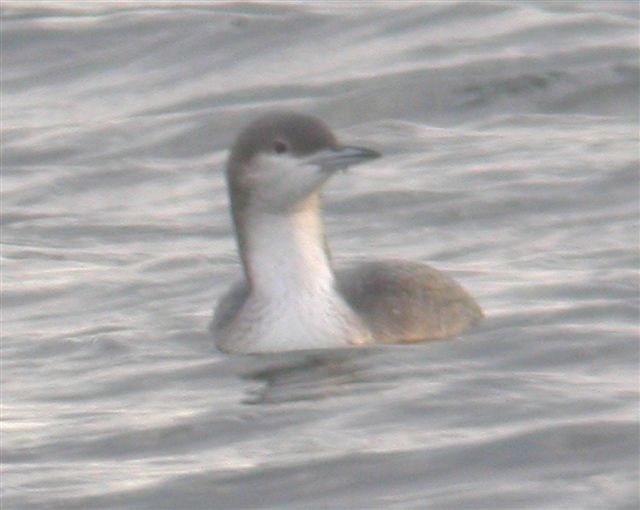
Black-throated Diver, Covenham Reservoir, Lincolnshire. This juvenile bird was present at the same time as the Farnham Pacific Diver. Comparing the two species this individual was clearly a larger-looking, chunkier bird with a heftier bill. The face pattern, seen in this front-on view, shows the greater extent of white, more typical of Black-throated. Although there is variation in this next feature, the upperparts were noticeably less strikingly pale and scaly when compared with the juvenile Pacific Diver (Martin Garner).
Bill shape and size
The bill of Pacific Diver clearly averages both thinner and shorter (data in Russell 2002) than that of Black-throated Diver. Black-throated Diver has quite a hefty bill, which can at times approach the 'weight' of Great Northern Diver. Birch and Lee (1995) noted that Black-throated Divers tend to hold the bill slightly more up-tilted whereas Pacific Divers usually hold the bill more level. In the case of the Yorkshire bird the bill was clearly not especially weighty and appeared rather thin; indeed, the overall effect (with the rather broad base evenly thinning to a very fine tip) could even be a little suggestive of Red-throated Diver at times.
Head shape
The head shape of Pacific Diver is less angular, less prone to 'lumpiness' on the forehead and less flat-topped than that often sported by Back-throated Diver. Obviously the head shape can vary with posture and behaviour, but the Yorkshire bird clearly had smoothly contoured crown with much of the bulk of the head positioned 'behind the eye'. Thus the nape often appeared 'puffed-up' or loose and 'fluffy' and the curiously 'ballooned' head shape of the Yorkshire bird helped underline the distinctiveness of at least some Pacific Divers!
Nape tone
One of the most striking features of the Yorkshire bird was the paleness of the nape. Indeed, when the nape was more extended and exposed (e.g. when preening), it appeared almost whitish and paler than is typical for Black-throated Diver. It is known that in adult breeding plumage the base of the nape feathers are white in Pacific Diver and grey in Black-throated Diver, and perhaps a similar difference exists in juvenile plumage. In any event the puffy pale nape, which seemed to get whiter when extended, suggested "the texture and composition of a bulrush" to one observer (Ian Lewington, pers. comm.) and was another useful character to add to the catalogue of pro-Pacific Diver features on this individual.
Pale fringes
The appearance of any vagrant bird inevitably invites further exploration towards the boundaries of identification. In the case of the Yorkshire Pacific Diver, the pale scapular fringes were particularly striking, being apparently both broader and perhaps paler than typical juvenile Black-throated Diver. Pale fringing on the dark flank and rump feathers also seemed more conspicuous than on juvenile Black-throated Diver (including a juvenile seen in the same week). The whole effect was of a noticeably paler, scalier bird. This particularly pale-scaled appearance of juvenile Pacific versus Black-throated Diver was reminiscent of the paler-fringed upperparts of juvenile White-billed Diver compared with Great Northern Diver. Reinking and Howell (1993) did consider a juvenile Black-throated Diver (presumably of the race viridigularis) they saw off California to be obviously darker and less strikingly pale-fringed above, with more noticeable contrast between the dark upperparts and pale nape than on a nearby juvenile Pacific Diver.
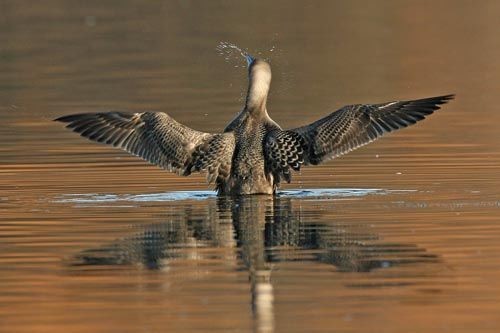
Pacific Diver, Farnham GPs, North Yorkshire. Although not fully appreciated in previous literature, it would appear that the pale fringing on the wings, scapulars and dark body feathers of juvenile Pacific Divers may often be appreciably broader, and paler, than on similarly aged Black-throated Divers. Maybe this particularly pale, scaly, appearance will help alert observers in the future who are keeping a keen lookout for the next record. The nape was clearly paler-looking than on typical Black-throated Diver, appearing at times almost whitish and mirroring known differences in the adult plumages (R L Brown).
Summary
The Yorkshire Pacific Diver could not have been a more obliging. Not only was it remarkable easy to observe and photograph, but the suite of field characters this particular individual exhibited were at the 'most useful end of the range' in terms of confirming its identification.
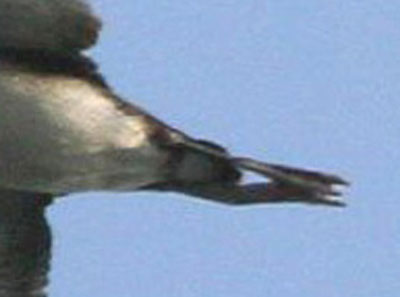
Pacific Diver, Farnham GPs, North Yorkshire. This close-cropped photo of the ventral area shows to wonderful effect the full dark vent strap on a juvenile Pacific Diver (Mark Breaks).
Taxonomy
Not surprisingly Pacific and Black-throated Diver have endured the same kind of roller-coaster taxonomic history through the 20th century as a number of other non-passerines. Such changes in taxonomic thinking had more to do with personal levels of interest and 'trends' than a consistent scientific approach. They were regarded as separate species by several authorities in the early to mid 1900s, but in subsequent years were more generally treated as being conspecific. However, a more recent appreciation of differences in voice and morphology has prompted the recognition of Pacific Diver as a full species for more than 20 years. The two were split by the American Ornithologists Union in 1985 (Auk 102:680-686). Pacific and Black-throated Diver have been shown to breed sympatrically in Western Alaska and northeastern Siberia (AOU 1998). Hybridization is unproven, though a number of specimens suggest that this may occasionally occur. This would not be surprising as both Pacific Diver and Black-throated Diver are reported to have hybridized with Great Northern Diver (Robertson and Fraker 1974; Hunter and Dennis 1972). The BOURC, of course, has no position on the taxonomy of Pacific Diver because it has hitherto not appeared on the British List. No doubt that will be addressed in the near future!
Postscript from Martin Garner
The Welsh diver
A bird first reported as a 'possible Pacific Diver' was found on 2nd February 2007 at Llys-y-Fran Reservoir (Pembrokeshire). Photos of this individual can be found on both the BirdGuides Picture Gallery.
Although not quite as strikingly obvious as the Yorkshire bird the photos of this individual clearly show a number of pro-Pacific features. These include the face pattern, a rather rounded and puffed out (and particularly pale) nape, striking pale, and scaly, upperparts (more so than on average juvenile Black-throated) and an apparently all-dark rear flank area. The bill looks rather large in some of the photos, though the absence of a dark throat bridle would be typical of nearly 50% of juvenile Pacific Divers, according to the figures, so should not be a concern. Observers of the bird stressed its small size (a little larger than a Great Crested Grebe!) and rather thin bill.
In summary it does indeed appear to be a good candidate for a Pacific Diver, albeit slightly less immediately convincing than the Yorkshire bird.
The Italian diver
A diver photographed on 24th November 2004 in Northern Italy has been touted in the past as a potential Pacific Diver and interest in its identification has not surprisingly resurfaced.
In my view the bird looks essentially like a rather typical Black-throated Diver. The bill is weighty, plus the face pattern and head shape are typical of juvenile Black-throated. However, there is no white visible on the rear flanks. It should be noted that in a number of the photos the bird is almost submerged and the wings appear to be partly underwater indicating how low-slung it is. This would not be unusual if the bird were fishing, for example. It needs to be a fully relaxed pose to see the correct area of the flanks properly. In other photos some white does indeed appear on the rear flanks, though apparently not as extensively as on a typical Black-throated Diver. It is hard to be certain whether the appearance of dark rear flanks is real or is just a result of the position it was photographed in. Most of the appearance is not convincing for identification as a Pacific Diver and it seems much more likely to be just an odd, or oddly photographed, Black-throated Diver.
Acknowledgements
With grateful thank to the bird's finder, June Atkinson, as well as Phil Bristow, Julian Hough, John Martin, Ian Lewington, Richard Millington, James Smith and Brian Small who all commented helpfully on this text.
References
American Ornithologists' Union. 1985. Thirty-fifth supplement to the American Ornithologists’ Union check-list of North American birds. Auk 102:680–686.
American Ornithologists' Union. 1998. Check-list of North American birds. 7th ed. Am. Ornithol. Union, Washington, D.C.
Birch, A., C.-T. Lee. 1995. Identification of Pacific Diver—a potential vagrant to Europe. Birding World 8:458–466.
Birch, A., C.-T. Lee. 1997. Arctic and Pacific Loons: field identification. Birding 29:106–115.
Hunter, E. N., R. H. Dennis. 1972. Hybrid Great Northern Diver × Black-throated Diver in Wester Ross. Scot. Birds 7:89–91.
Kaufmann, K.. 1990. Advanced birding. Houghton Mifflin, Boston.
Reinking, D. L., S. N. G. Howell. 1993. An Arctic Loon in California. West. Birds 24:189–196.
Robertson, I., M. Fraker. 1974. Apparent hybridization between a Common Loon and an Arctic Loon. Can. Field-Nat. 88:367.
Russell, R. W. 2002. Pacific Loon (Gavia pacifica) and Arctic Loon (Gavia arctica). In The Birds of North America, No. 657 (A. Poole and F. Gill, eds.). The Birds of North America, Inc., Philadelphia, PA.
Walsh, T. 1988. Identifying Pacific Loons: some old and new problems. Birding 20: 12–28.

